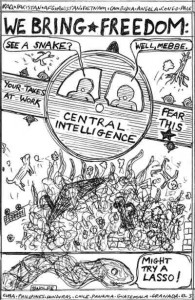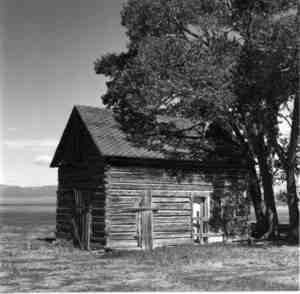Essay by Dennis Hinkamp
Brokeback Mountain – March 2006 – Colorado Central Magazine
The movie Brokeback Mountain moved slowly through film festivals, winning raves, then on to limited release, and now it’s up for a pile of Oscars and is making wannabe Westerners think twice about wearing that Stetson.
In Salt Lake City, theater-owner Larry Miller ramped up the rhetoric by canceling a showing at one of his venues. Miller owns large chunks of the Salt Lake City economy, including the Utah Jazz basketball team, a community college campus, a throng of Honda and Toyota dealerships, and assorted entertainment spots from theaters to automobile racetracks. It’s no secret he made up his mind about the movie early on.
For historical reference, Miller is the same tons-of-fun guy who once came boiling out of the stands to fight a basketball player he disapproved of. He also signed alleged Jazz basketball center Craig Ostertag twice. So you can see that prudence is not a big part of his skill set.
While I enjoyed both the 1997 versions of the Jazz and Honda Accord, I can’t cut Miller much slack here. He cancelled Brokeback Mountain while the movie was showing in the outer provinces of Logan, Utah, where I live. Salt Lake City is a mere $110 cab ride from Park City and the always-edgy Sundance Film Festival. One would think “who cares?” But the really crazy part is he canceled the movie without even seeing it.
Like Miller, most people don’t really see the West before they make up their minds. They cancel out the reality and insert what they think it should be. People still think the West is idyllic and immune from statistics and the laws of probability. That’s really the only thing that makes the movie shocking. The movie wouldn’t make news, and Brokeback Mountain wouldn’t be up for a rusty pick- up truckload of awards, if it were not set in the cowboy West of a few decades ago. The truth is: Gays, lesbians, Democrats, Republicans, poverty, drug use, divorce, fundamentalists, homicidal teenagers and tree- huggers all coexist in the West and always have. The cowboy West really only existed in Marlboro County ads and tourist posters.
The marketing teams forgot to mention that just off-camera, there were lots of regular people living their gay, straight or in-between lives.
The movie is based on a story by Annie Proulx that was originally published in the New Yorker magazine before being brought to the screen by a Taiwanese director. So maybe it just took Easterners and a far Easterner to bring Proulx’s heartfelt, place- based tale of forbidden and dangerous love to the public. You do have to wonder why they chose the West as the setting. One answer is that a gay couple living in Manhattan or San Francisco is nothing new and fairly safe. You’re not safe in a culture that makes 100 percent macho men the only men allowed — even in the liberal 1960s, where the movie romance begins.
But that dang press keeps getting it wrong. They keep calling it a “gay cowboy movie” when anyone with a Western eye for detail can quickly point out that it is more a gay sheepherder movie. This is a pretty big error in continuity, since in the real history of the West, sheep and cattle mixed about as freely as Yankees and Confederates.
As a side note, some of the only special effects in this languorous tale involve fake sheep. Getting two Hollywood leading- man hunks to act out a love story was nothing compared to trying to get a thousand sheep to walk along the edge of a cliff in just the right light. Director Ang Lee obviously didn’t do much research on Suffolk sheep, so he had to digitally add a few hundred to the flock.
Another maddening twist is that the spectacular scenery in the movie wasn’t made in Wyoming; most of the movie was shot in Alberta, Canada. So all in all, Western purists can sleep comfortably knowing that this movie was only a Taiwanese misinterpretation set against a liberal Canadian backdrop.
Apparently, this hasn’t stopped an influx of calls to the Wyoming office of tourism. Even when people are told that the movie’s backdrop is the Canadian Rockies, they don’t seem to care. They still like the idea of Wyoming better than the real place.
Dennis Hinkamp is a contributor to Writers on the Range, a service of High Country News in Paonia, Colorado (hcn.org). He lives in Logan, Utah, where he works in extension communications for Utah State University.


